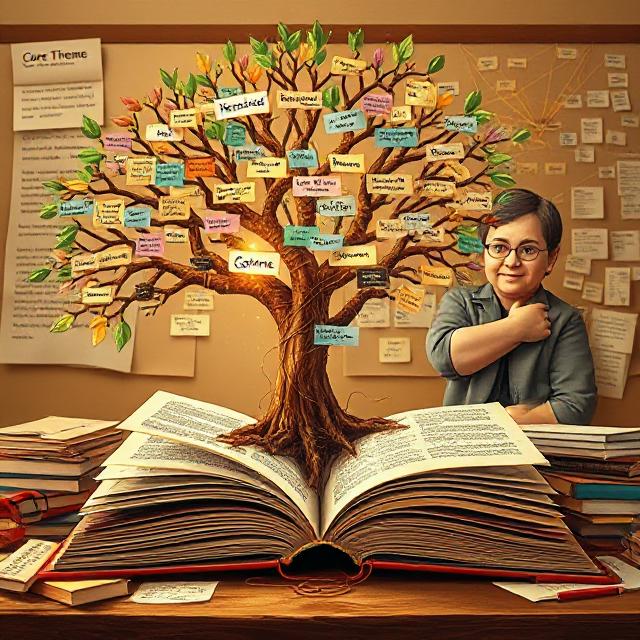
Table of Contents
Mapping Knowledge Trees: Visual Tools for Syntopic Learning
Syntopic learning is about integrating diverse sources into a cohesive understanding—but how do you see the connections forming? How do you capture contradictions, trace insights, and retain it all meaningfully?
That’s where mapping knowledge trees becomes your secret weapon.
Knowledge trees turn a web of ideas into an organized, living map—branching from core themes into layered insights. Whether you’re learning philosophy, biology, or productivity systems, this tool helps your brain think in structure.
Let’s explore what knowledge trees are, why they work, and how to use them to amplify your syntopic learning practice.
🌳 What Are Knowledge Trees?
A knowledge tree is a visual diagram that organizes ideas in a tree-like format. The “trunk” is your main theme or question. The “branches” are subtopics. The “leaves” are specific data points, quotes, contradictions, or real-world applications.
Unlike linear outlines, knowledge trees allow for:
- Nonlinear structure (thinking beyond one source or order)
- Comparison of perspectives
- Integration of conflicting views
- Spatial memory anchoring
This mirrors how our brains naturally store information—relationally.
Instead of learning from A → B → C, you’re building a mental landscape of concepts that interlink, reinforce, or challenge one another.
🧠 Why Knowledge Trees Boost Memory and Insight
According to dual coding theory (Paivio, 1971), combining verbal and visual input improves understanding and retention. Mapping engages:
- Visual-spatial reasoning
- Semantic association
- Active recall
- Metacognitive planning
It turns study from consumption into construction—transforming knowledge into insight.
This is especially useful in syntopic learning, where you’re pulling together information from multiple domains, books, lectures, or traditions.
Knowledge trees help your brain not just absorb—but organize, prioritize, and synthesize.
🧩 How to Build a Knowledge Tree (Step-by-Step)
1. Choose a Core Theme (The Trunk)
Everything branches from here.
Examples:
- “Neurotransmitters that affect focus”
- “Different models of free will”
- “How gut health affects cognition”
Write this at the center of your page or digital canvas.
2. Gather Sources (The Roots)
These are the materials that feed your tree:
- Books
- Research articles
- Podcasts
- Lecture notes
- Blog posts
- Personal experiences
List them at the base. Be sure to include conflicting viewpoints—syntopic learning thrives on comparison.
3. Identify Major Concepts (The Branches)
From your core theme, identify 3–6 core subtopics that emerge.
Example for “Gut-Brain Axis”:
- Gut microbiome and mental health
- Inflammation and depression
- Vagus nerve signaling
- Probiotic interventions
- Cultural gut practices
Each of these becomes a major branch.
4. Add Details (The Leaves and Twigs)
Now fill each branch with:
- Quotes and definitions
- Study results or findings
- Historical interpretations
- Real-life applications
- Points of contradiction
You can use sticky notes, color codes, or digital nodes depending on your platform.
This helps you track not just facts—but how ideas interact.
5. Draw Connections Across Branches
The magic happens here.
Draw lines between related ideas from different branches. For example:
- “Inflammation” might affect both gut microbiota and neurotransmitter production.
- “Cultural fasting” from one source may intersect with “gut lining repair” from another.
This creates a web of meaning and promotes systems thinking.
6. Add Personal Reflection and Questions
Around the edge of your tree, write:
- Questions that emerged
- Insights you gained
- Confusions you want to clarify
- How this links to your life or goals
This layer makes your learning reflective, not just accumulative.
🛠️ Tools for Mapping Knowledge Trees
Analog Options:
- Whiteboards
- Large paper sketchpads
- Sticky notes with movable branches
- Color-coded pens
Digital Tools:
- XMind – Flexible tree diagrams
- Obsidian – Markdown notes + visual graph
- Miro / Whimsical – Infinite canvases for mapping
- Notion – Embed links and database views
- Coggle – Collaborative visual trees
Choose the medium that makes cognition feel fluid, not forced.
🧬 Why It Works: Cognitive Science Behind Tree Mapping
Knowledge trees are grounded in:
- Cognitive Load Theory – Trees reduce overwhelm by segmenting complex topics
- Constructivism – You learn more deeply when you build knowledge structures
- Schema Theory – Trees help form durable memory networks
They mimic the way real neurons branch and connect—form follows function.
Mapping isn’t an aesthetic—it’s a cognitive amplifier.
🌐 Real-Life Example: Synthesizing Philosophy
Suppose you’re exploring ethics across cultures.
- Trunk: Moral decision-making models
- Branches:
- Utilitarianism (Mill, Bentham)
- Deontological ethics (Kant)
- Confucian virtue ethics
- Indigenous moral frameworks
- Modern applied ethics
On each branch:
- Compare definitions of “good”
- List historical roots
- Note key thinkers
- Mark contradictions
- Add your takeaways
Result: Instead of memorizing definitions, you develop an integrated moral framework.
🔄 Make It a Habit: Weekly Tree-Building Rituals
You don’t need a new tree every day. Try:
- One core tree per week
- Small updates as you read/listen
- Monthly tree reviews to consolidate insight
Trees are most powerful when they evolve. Make yours a growing forest of knowledge.
💡 Bonus: Tips for Better Trees
- Use color: Assign a color per source or subtopic
- Mind map hybrids: Combine radial and vertical layouts
- Index your trees: Keep a personal “Tree Vault” by theme
- Layer in timelines: If your topic spans history, add a time axis
- Teach from your trees: Explain one to a friend to lock it in
✍️ Final Reflection: Build the Forest, Not Just the Branches
Mapping knowledge trees isn’t busywork—it’s a profound act of cognitive engineering. It allows you to:
- Turn confusion into clarity
- Turn information into transformation
- Turn scattered learning into syntopic wisdom
Each tree is a map of how you think. Each branch is a trace of insight earned.
So next time you sit down to study…
Don’t just highlight. Draw.
Don’t just collect. Connect.
Don’t just read. Grow.